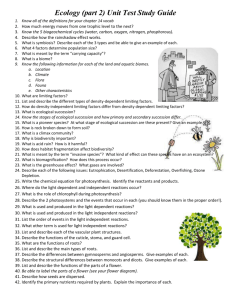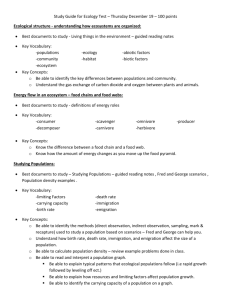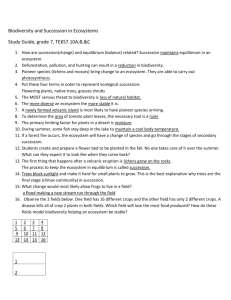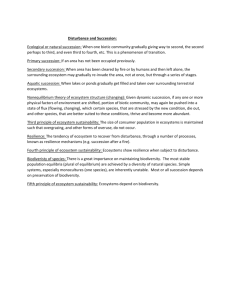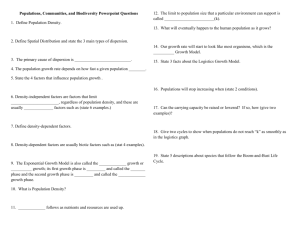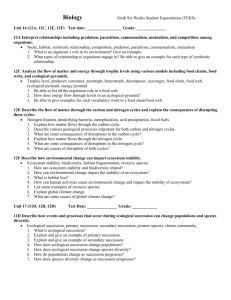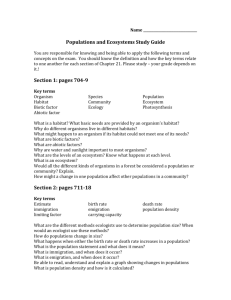The Long and Short Story of Ecological Succession – Grade Seven
advertisement
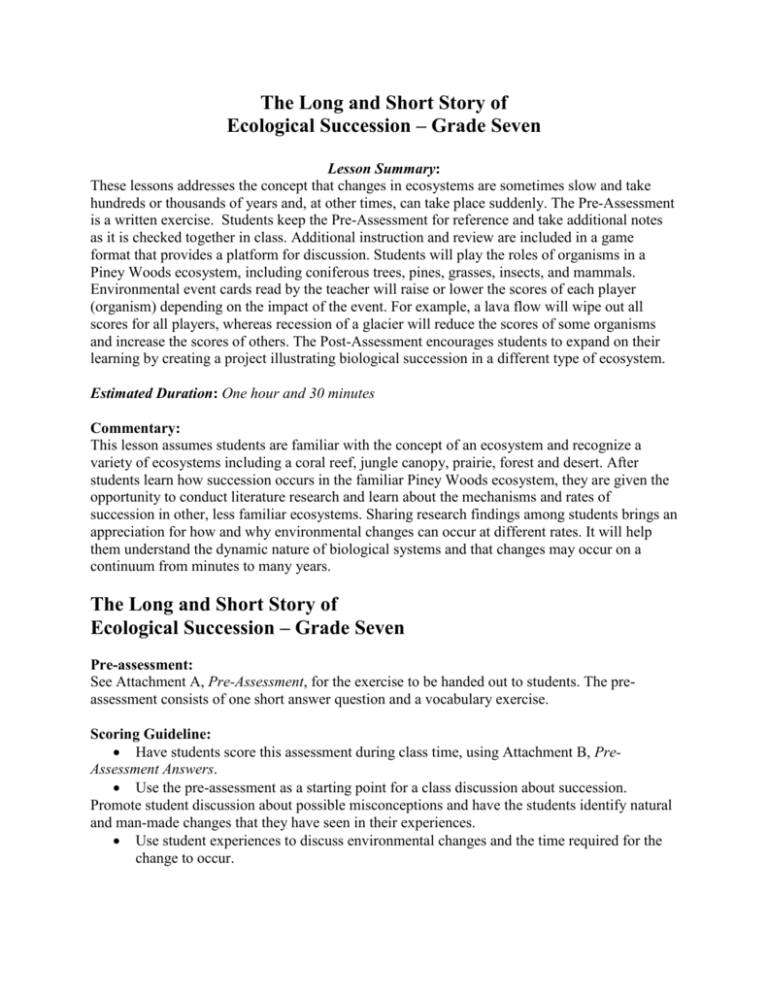
The Long and Short Story of Ecological Succession – Grade Seven Lesson Summary: These lessons addresses the concept that changes in ecosystems are sometimes slow and take hundreds or thousands of years and, at other times, can take place suddenly. The Pre-Assessment is a written exercise. Students keep the Pre-Assessment for reference and take additional notes as it is checked together in class. Additional instruction and review are included in a game format that provides a platform for discussion. Students will play the roles of organisms in a Piney Woods ecosystem, including coniferous trees, pines, grasses, insects, and mammals. Environmental event cards read by the teacher will raise or lower the scores of each player (organism) depending on the impact of the event. For example, a lava flow will wipe out all scores for all players, whereas recession of a glacier will reduce the scores of some organisms and increase the scores of others. The Post-Assessment encourages students to expand on their learning by creating a project illustrating biological succession in a different type of ecosystem. Estimated Duration: One hour and 30 minutes Commentary: This lesson assumes students are familiar with the concept of an ecosystem and recognize a variety of ecosystems including a coral reef, jungle canopy, prairie, forest and desert. After students learn how succession occurs in the familiar Piney Woods ecosystem, they are given the opportunity to conduct literature research and learn about the mechanisms and rates of succession in other, less familiar ecosystems. Sharing research findings among students brings an appreciation for how and why environmental changes can occur at different rates. It will help them understand the dynamic nature of biological systems and that changes may occur on a continuum from minutes to many years. The Long and Short Story of Ecological Succession – Grade Seven Pre-assessment: See Attachment A, Pre-Assessment, for the exercise to be handed out to students. The preassessment consists of one short answer question and a vocabulary exercise. Scoring Guideline: Have students score this assessment during class time, using Attachment B, PreAssessment Answers. Use the pre-assessment as a starting point for a class discussion about succession. Promote student discussion about possible misconceptions and have the students identify natural and man-made changes that they have seen in their experiences. Use student experiences to discuss environmental changes and the time required for the change to occur. Post-Assessment: Explain to the students that they have been learning about ecological succession in only one system, the Piney Woods of East Texas. Review the steps of succession in the Piney Woods on the board to be sure students understand the concept of the climax community. Tell students that their job is to discover how succession works in other communities of living things. This is a good opportunity to remind students about biotic and abiotic factors and the interdependence of species. Divide the class into groups of three to four students. Tell each group that they will create a mini-history lesson about life in a community of living things spanning 100 years, and share this lesson with the rest of the class. Students may choose one of the following ecosystems: Pond – Primary succession Coral reef – Primary Succession Desert – Secondary succession Swamp – Secondary succession Rain forest – Secondary succession Seashore – Secondary Succession Put the instructions from Attachment C, Post-Assessment, on the board, an overhead or handout so that all students understand the assessment. You may choose to have students keep a log of their research for you to review before they write and present their findings. Scoring Guideline: See Attachment D, Post-Assessment Rubric, to help in assessing student work. The rubric should also be distributed to students prior to the exercise to guide their work. The Long and Short Story of Ecological Succession – Grade Seven Instructional Procedures: 1. Give the Pre-Assessment and grade in class. 2. Direct students to take notes and make corrections as needed. 3. Clear up misconceptions about ecosystems at this time, helping students understand their dynamic nature. 4. Introduce the classroom activity. Explain that the class is going to be playing a game. See: Attachment E, Game Instructions; Attachment F, Player Cards; Attachment G, Event Cards. 5. Have students play the game, observing and directing their play. Extend or abbreviate the game as desired. The game is not designed to be fair, but to stimulate discussion about ecological change. 6. Have students share scores and discuss why they believe some groups did better than others. 7. Ask the students to brainstorm by asking the following questions, and having them discuss the answers in small groups. What did this game teach you about the speed of plant and animal succession in an ecosystem? Did you think it was realistic? Why or why not? Instructional Tip: The students should be able to identify ways in which the game is inconsistent with real ecological succession. For example, environmental changes may not occur in the same order as in the game. Organisms may have different abilities to survive than depicted in Attachment G, Event Cards depending on the other organisms that live in the community. Regardless, students should be able to observe that some types of organisms survive well in newly disturbed environments, whereas other organisms survive well only in stable, undisturbed areas. 8. Lead a class discussion of the questions that they answered in small groups. As homework for the next class period, have students answer the following question on a sheet of paper. In a three-to five sentence paragraph, explain what this game taught you about the speed of plant and animal succession in a community. Be specific and use appropriate vocabulary such as primary succession, secondary succession, climax community, and pioneer organisms. 9. Collect questions the following day and assess for understanding. 10. Assign the Post-Assessment. The Post-Assessment is created by a small group of students working together to gather information. They design a presentation (e.g. poster, skit, or model) and write a brief paragraph to be presented to the class as a whole. Its purpose is to review succession and broaden students' views of succession in one ecosystem (the Piney Woods) to other ecosystems such as the coral reef or a pond. 11. Give the students the directions for the post-assessment. Allow students time to conduct their literature research, and allow time in class for groups to use their information to complete the post-assessment task. Differentiated Instructional Support: Instruction is differentiated according to learner needs, to help all learners either meet the intent of the specified indicator(s) or, if the indicator is already met, to advance beyond the specified indicator(s). This lesson includes a number of ways to include differentiated instruction. Students are required to take notes, talk about ideas, and create graphic representations. You may want to take extra time to discuss cards specifying student roles (tree, insects, etc.) with the class to be sure students understand the differences in the roles and to ask any additional questions. Extension: Many parks have created nature boardwalks over swampy areas that were once lakes. A field trip to one of these areas and a talk by one of the park experts would provide students with a real-life experience to add to their research. Homework Options and Home Connections: While driving/traveling with family or friends, students may want to look for environmental changes that have occurred and try to determine the cause (e.g. landslide, erosion, fire, human impact, and construction.) What changes were slow? Rapid? Students could take pictures of their findings and share with the class. Interdisciplinary Connections: Social Studies Geography Benchmark B: Define and identify regions using human and physical characteristics. Indicator 3: Describe changes in the physical and human characteristics of regions that occur over time and identify the consequences of such changes. The Long and Short Story of Ecological Succession – Grade Seven For the teacher: Game cards and directions, background material on a variety of ecosystems, calculators (optional), electronic presentation program (optional). For the student: Game cards and directions, background material on a variety of ecosystems, calculators (optional), electronic presentation program (optional). Vocabulary: climax community diversity ecosystem lichens pioneer organisms primary succession secondary succession succession Technology Connections: Have students use the Internet to search for credible information about ecological succession. You may have students use computer presentation programs to present their findings to the class. Research Connections: Marzano, R. et al. Classroom Instruction that Works: Research-based Strategies for Increasing Student Achievement. Alexandria: Association for Supervision and Curriculum Development, 2001. Identifying similarities and differences enhances students’ understanding of and ability to use knowledge. This process includes comparing, classifying, creating metaphors and creating analogies and may involve the following: Presenting students with explicit guidance in identifying similarities and differences; Asking students to independently identify similarities and differences; Representing similarities and differences in graphic or symbolic form. Summarizing and note taking are two of the most powerful skills to help students identify and understand the most important aspects of what they are learning. The Long and Short Story of Ecological Succession – Grade Seven Homework and practice provide students with opportunities to deepen their understanding and skills related to content that has been presented to them. General Tips: This lesson assumes students are familiar with the concept of an ecosystem and recognize a variety of ecosystems including a coral reef, jungle tree tops, prairie, forest and desert. The teacher should feel free to modify the game to suit the needs of her/his own classroom setting. The teacher should monitor group work and students should be encouraged to come to the teacher when problems occur in their groups just as they would if they had difficulty understanding a concept. Attachments: Attachment A, Pre-Assessment Attachment B, Pre-Assessment Answers Attachment C, Post-Assessment Attachment D, Post-Assessment Rubric Attachment E, Game Instructions Attachment F, Player Cards Attachment G, Event Cards The Long and Short Story of Ecological Succession – Grade Seven Attachment A- Pre-Assessment Ecological Succession Name ___________________ Part I Explain how a forest ecosystem goes through a cycle of birth, growth, maturity, stability and death. Part II Use the following words and phrases to fill in the blanks with the best possible match. You will use several of the terms more than once. ecosystem diversity lichens succession primary succession secondary succession pioneer organisms climax community 1. A forest of pine trees is burned over a 10 mile area when lightning strikes a tree. In the spring, a few seedlings are beginning to sprout. ___________________________________ 2. A glacier has scraped all soil from a rocky area. As it slowly retreats, some of the rock is broken down by weathering. Some moss begins to grow. ___________________________________ 3. A small symbiotic organism secretes acid into the rock to anchor itself in place. ___________________________________ 4. The old-growth forest has remained the same combination of hickories and oaks for 100 years. ___________________________________ 5. Small organisms, such as lichens, help break up bare rock into soil. ___________________________________ 6. This may take hundreds or thousands of years. ___________________________________ 7. A pond slowly fills in as algae and other plants die and fall to the bottom. ___________________________________ 8. A volcano erupts creating a new island. After a few years, small plants begin to grow. ___________________________________ 9. This term describes a community of organisms and the biotic factors (air, water, etc.) that make up the environment in which they live. ___________________________________ 10. Sand dunes, ponds, oak trees and coral reefs are examples of ___________________________________ The Long and Short Story of Ecological Succession – Grade Seven Attachment B Pre-Assessment Answers Part I. Explain how a forest ecosystem goes through a cycle of birth, growth, maturity, stability and death. Possible answer: Lichens break down bare rock. The decaying of lichens and the broken rock particles create soil which is used to establish mosses. The mosses grow and die and further break down the rock. Ferns take over, then grasses, then shrubs and finally trees. Part II. Use the following words and phrases to fill in the blanks with the best possible match. You will use several of the terms more than once. Answers: 1. A forest of pine trees is burned over a 10 mile area when lightning strikes a tree. In the spring, a few seedlings are beginning to sprout. secondary succession 2. A glacier has scraped all soil from a rocky area. As it slowly retreats, some of the rock is broken down by weathering. Some moss begins to grow. primary succession 3. A small symbiotic organism secretes acid into the rock to anchor itself in place. primary succession 4. The old-growth forest has remained the same combination of hickories and oaks for 100 years. climax community 5. Small organisms, such as lichens, help break up bare rock into soil. pioneer organisms 6. This may take hundreds or thousands of years. succession 7. A pond slowly fills in as algae and other plants die and fall to the bottom. secondary succession 8. A volcano erupts creating a new island. After a few years, small plants begin to grow. primary succession 9. This term describes a community of organisms and the biotic factors (air, water, etc.) that make up the environment in which they live. ecosystem 10. Sand dunes, ponds, oak trees and coral reefs are examples of ecosystem The Long and Short Story of Ecological Succession – Grade Seven Attachment C Post-Assessment Directions for Post-Assessment 1. Investigate your ecosystem and its communities by using the Internet and/or textbooks and articles. 2. Take notes and/or make copies of information that help you understand the key environmental factors (biotic and abiotic). 3. Sketch a timeline of the life of the ecosystem and how both biotic and abiotic factors have changed over time. 4. Choose one organism (insect, tree, lichen, etc.) in the community to tell the story of the environmental changes that may take place Use this character as your narrator. 5. Create a comic strip, flipbook, rap, skit, electronic presentation or diorama to tell a possible history of the area. Be sure your changes are realistic. 6. Draw, use clip art or pictures from magazines to illustrate your work. 7. Write a brief paragraph explaining what you found and the length of time it took for the steps in succession to occur that led to a climax community. The Long and Short Story of Ecological Succession – Grade Seven Attachment D Post-Assessment Rubric The Long and Short Story of Ecological Succession – Grade Seven Attachment E Game Instructions Game: This Time Next Time Background: This is the East Texas Piney Woods ecosystem Materials: Player cards (enough for each student to have one) Event cards (teacher pulls) Calculator (optional) Directions: 1. Make enough player cards (Attachment F) so that each student receives one. 2. Explain to the students that they will represent groups of living things that are affected by ecological succession (review succession as necessary). 3. Pass cards out to students so that different card types are distributed around the room. 4. Have all the insects stand up and have one person read his/her card aloud so that everyone in the class knows about the basic characteristics. Continue standing and reading player cards until all groups have been identified. Ask students if anyone would like to trade cards with another (e.g., an insect for tree). If two people are willing to trade, they can switch cards. 5. Draw event cards (Attachment G) one at a time and display them to the students. Ideally, as you draw each card, place it on an overhead as it is read so students can see how many points they get to add or subtract from their scores. 6. Each player starts with 100 points of his/her own. The points represent how well the type of organism is surviving. The object of the game is to keep as many survival points as possible. Students should use calculators or pencils and paper to keep track of their scores. 7. Continue until all event cards have been used. The Long and Short Story of Ecological Succession – Grade Seven Attachment F Player Cards Insects: You are very small and weak, but can multiply very rapidly. One adaptation that makes you more likely to survive is that you can hide easily and live in very small places. Lichens: You are a pioneer organism. You alone of all the organisms can survive on bare rock. You are found everywhere on living and dead material. You are a symbiotic combination of algae and fungus. The fungus helps you hold onto the rock and break it down; the algae helps you make food. Pines: You are a fast-growing tree. You can beat other trees into the area and grow fast enough to shade other plants from the sun so that they die. Your needles make the soil inhospitable for grasses. The Long and Short Story of Ecological Succession – Grade Seven Attachment F (continued) Player Cards Grasses: You are small and fast-growing. You can take over an area very quickly as long as there is a little bit of soil. You have a strong root system and are able to hold onto the soil that is available. Oaks and Maples: You are the strongest of the plants and live the longest. With your many branches and big leaves you crowd out other plants and keep the sun from reaching them. You usually live the longest of any biotic component of the ecosystem and form what is called the climax community (the group that will not be crowded out by other organisms). Mammals: Some of you are very large and can move very quickly. You are often considered the most beautiful species of the forest (may include mice, deer, wolves, etc.). The Long and Short Story of Ecological Succession – Grade Seven Attachment G Event Cards The Long and Short Story of Ecological Succession – Grade Seven The Long and Short Story of Ecological Succession – Grade Seven The Long and Short Story of Ecological Succession – Grade Seven


